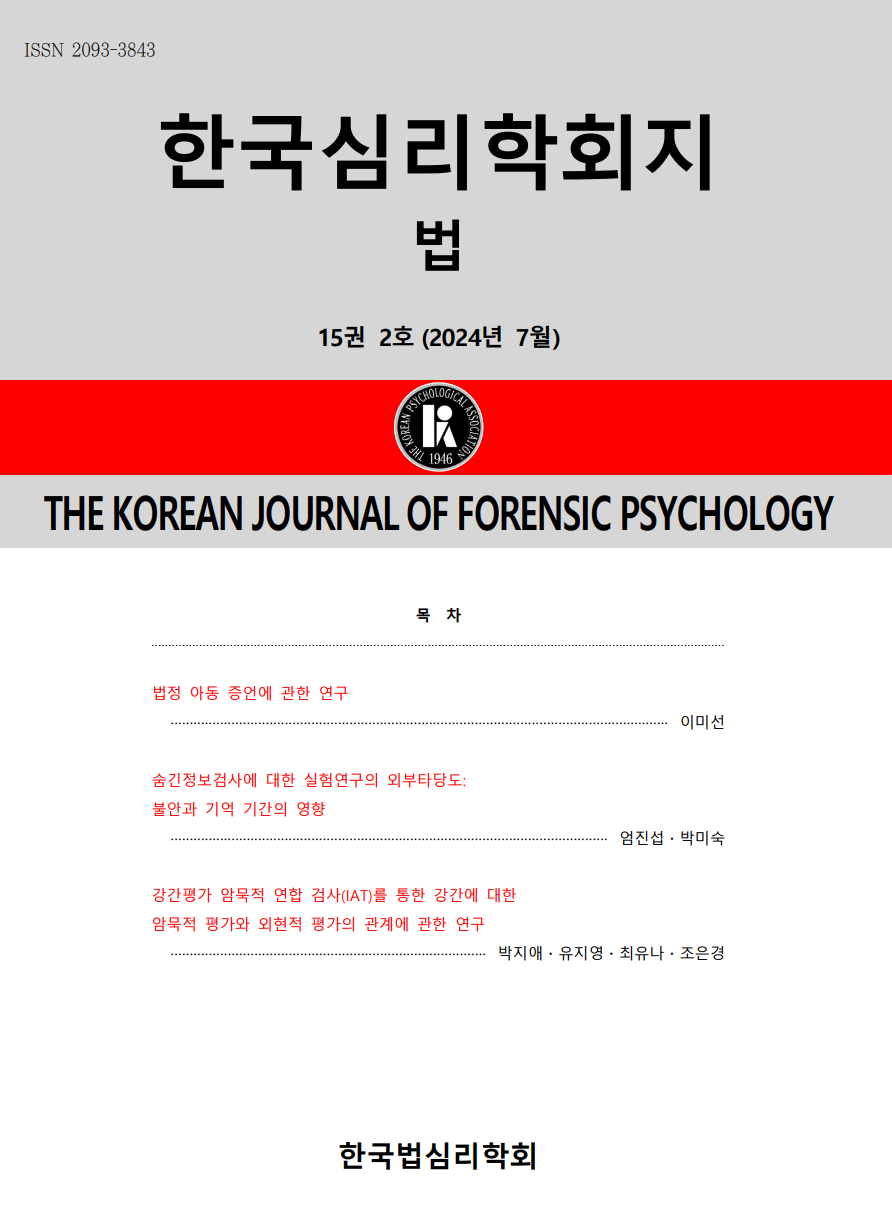 ISSN : 2093-3843
ISSN : 2093-3843
The aim of the present study is to examine difference between juvenile offenders with and without previous criminal records, to identify risk factors which influence re-offending of juvenile offenders, and eventually to prevent juvenile offenders from committing crime. Based on the results from risk assessment tool for juvenile offenders, the present study investigated difference between juvenile offenders with and without previous criminal records. Case reports of a total of 201 juvenile offenders who had committed crime in the various areas of Seoul and Yongin were analyzed. As a result, considerable differences were found between two groups of juvenile offenders, in terms of family structure, family functioning, school life, elopement, criminal history, and personal factors. Finally, limitations of the present study were discussed and suggestions for future research were made.
고제원․이규호․이민희 (2010). 비행청소년의범죄유형별 PAI 프로파일. 법학연구, 39, 157-176.
김의철․박영신․탁수연 (2010). 보호관찰청소년과 일반청소년의 친구관계 비교 분석. 한국심리학회지: 사회문제, 16(4), 487-508.
김지선 (2007). 청소년범죄의 발생추세와 특성: 1996-2005년. 형사정책, 19(2), 55-86.
김헌수․김현실 (2001). 재범 비행 청소년의예측인지 분석. 신경정신의학회지, 40(2), 279-291.
김희화 (2001). 청소년의 초기 비행과 지속적 비행에 대한 영향 요인. 청소년학연구, 8(1), 143-162.
노일석 (2009). 청소년 절도사범 재범 예측 요인: 절도 소년보호관찰대상자 재범위험성평가도구(LJP-RRAR) 개발 연구. 한국심리학회지: 일반, 28(2), 449-470.
대검찰청 (2013). 2013 범죄 분석. 서울: 대검찰청.
박영신․김의철 (2010). 친구가 청소년의 일탈행동에 미치는 영향: 자기효능감, 부모자녀 갈등 및 부모의 통제를 중심으로. 한국심리학회지: 사회문제, 16(3), 385-422.
서동혁․정선주․손창호․김원식․고승희․함봉진․조성진․김영기․이중재 (2001). 구속된 비행 청소년들의 석방 후 6개월 이내 재범의 예측요인. 신경정신의학, 40(3), 463-476.
신경민․신윤미․김선영․조선미 (2010). 청소년기 비행 행동의 초기 위험 요인: 6-8년종단 연구. 한국심리학회지: 임상, 29(2), 597-606.
양종국․김충기 (2002), 비행 청소년의 비행위험 요인 및 보호요인과 재비행간의 관계. 청소년상담연구, 10(2), 101-121.
이남희․이봉건 (2009). 비행청소년의 범죄유형에 따른 재범 위험성 차이에 관한 연구-비행촉발요인 조사서와 PAI 검사결과를중심으로. 한국심리학회지: 사회및성격, 23(2), 127-140.
이동원 (2003). 소년범죄자의 재범특성에 관한고찰: 범행의 발전양상과 재범가능성을중심으로. 형사정책, 15(2), 335-366.
이수정 (2007). 경찰단계에서의 범죄소년 다이버젼을 위한 비행성 평가절차의 재범예측력 연구. 한국심리학회지: 사회및성격, 21(2), 47-57.
이수정․조은경 (2005). 경찰단계에서의 소년범 위험성 평가를 위한 비행촉발요인 조사도구 개발. 한국심리학회지: 사회및성격, 19(1), 27-43.
이희정․이성칠 (2005), 보호관찰 청소년의 사회 심리적 특성: 초범군과 재범군의 비교. 아동학회지, 26(5), 367-377.
정선주․김원식․고승희․구영진․김홍창․서동혁 (1999). 구속된 비행 청소년들의 특성 및 석방 후 6개월간 재범여부와 관련된 변인. 소아청소년정신의학, 10(2), 201-211.
조윤오 (2012). 소년원 퇴원 후의 재범 유발요인에 대한 연구. 청소년학연구, 19(2), 79-98.
한기혜․박영신 (2005), 보호관찰 청소년의 가정환경과 부모자녀관계. 아동교육, 13(1), 95-109.
황진규 (2011). 보호관찰 청소년의 환경요인및 보호관찰 개입과 재범과의 관계성 연구: 비재범자와의 비교분석을 중심으로. 한국심리학회지: 법정, 2(2), 115-133.
Dembo, R., Turner, G. S., Sue, C., Schmeidler, J., Borden, P., & Manning, D. (1995). Predictors of recidivism to a juvenile assessment center. International Journal of the Addictions, 30, 1425-1452.
Fergusson, D. M., & Horwood, L. J. (1996). The role of adolescent peer affiliations in the continuity between childhood behavioral adjustment and juvenile offending. Journal of Abnormal Child Psychology, 24, 205-221.
Frick, P. J., Cornell, A. H., Bodin, S. D., Dane, H. E., Barry, C. T., & Loney, B. R. (2003). Callous-unemotional traits and developmental pathways to severe conduct problems. Developmental Psychology, 39(2), 246-260.
Marquis, P. (1992). Family dysfunction as a risk factor in the development of antisocial behavior. Psychological Reports, 71, 468-470.
Morey, L. C. (1991). The Personality Assessment Inventory manual. Odessa, FL: Psychological Assessment Resources.